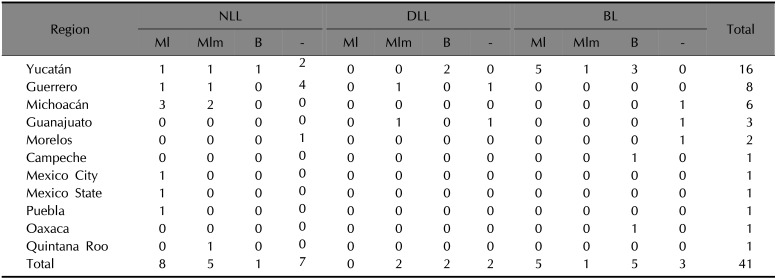1. Lupi O, Madkan V, Tyring SK. Tropical dermatology: bacterial tropical diseases. J Am Acad Dermatol. 2006; 54:559–578. PMID:
16546577.

2. Han XY, Seo YH, Sizer KC, Schoberle T, May GS, Spencer JS, et al. A new mycobacterium species causing diffuse lepromatous leprosy. Am J Clin Pathol. 2008; 130:856–864. PMID:
19019760.
3. World Health Organization. Global leprosy update, 2015: time for action, accountability and inclusion. Wkly Epidemiol Rec. 2016; 91:405–420.
5. Han XY, Sizer KC, Thompson EJ, Kabanja J, Li J, Hu P, et al. Comparative sequence analysis of mycobacterium leprae and the new leprosy-causing mycobacterium lepromatosis. J Bacteriol. 2009; 191:6067–6074. PMID:
19633074.
6. Han XY, Sizer KC, Velarde-Félix JS, Frias-Castro LO, Vargas-Ocampo F. The leprosy agents mycobacterium lepromatosis and mycobacterium leprae in Mexico. Int J Dermatol. 2012; 51:952–959. PMID:
22788812.

7. Han XY, Mistry NA, Thompson EJ, Tang HL, Khanna K, Zhang L. Draft genome sequence of new leprosy agent mycobacterium lepromatosis. Genome Announc. 2015; 3:e00513–e00515. PMID:
25999555.

8. Singh P, Benjak A, Schuenemann VJ, Herbig A, Avanzi C, Busso P, et al. Insight into the evolution and origin of leprosy bacilli from the genome sequence of mycobacterium lepromatosis. Proc Natl Acad Sci U S A. 2015; 112:4459–4464. PMID:
25831531.

9. Cox RA, Kempsell K, Fairclough L, Colston MJ. The 16S ribosomal RNA of mycobacterium leprae contains a unique sequence which can be used for identification by the polymerase chain reaction. J Med Microbiol. 1991; 35:284–290. PMID:
1719203.
10. Pfaltzgraff RE. What is the actual male/female sex ratio in leprosy patients? Lepr Rev. 2003; 74:180–181. PMID:
12862262.
11. Atoche C, Torres-Guerrero E, Vargas F, Arenas R. [Leprosy in Yucatan, retrospective clinical study of 63 years (1950–2013)]. Salud Publica Mex. 2015; 57:191–192. Spanish. PMID:
26302115.
12. Han XY, Aung FM, Choon SE, Werner B. Analysis of the leprosy agents mycobacterium leprae and mycobacterium lepromatosis in four countries. Am J Clin Pathol. 2014; 142:524–532. PMID:
25239420.

13. Vera-Cabrera L, Escalante-Fuentes WG, Gomez-Flores M, Ocampo-Candiani J, Busso P, Singh P, et al. Case of diffuse lepromatous leprosy associated with “mycobacterium lepromatosis”. J Clin Microbiol. 2011; 49:4366–4368. PMID:
22012006.

14. Vera-Cabrera L, Escalante-Fuentes W, Ocampo-Garza SS, Ocampo-Candiani J, Molina-Torres CA, Avanzi C, et al. Mycobacterium lepromatosis infections in Nuevo León, Mexico. J Clin Microbiol. 2015; 53:1945–1946. PMID:
25809978.

15. Han XY, Sizer KC, Tan HH. Identification of the leprosy agent mycobacterium lepromatosis in Singapore. J Drugs Dermatol. 2012; 11:168–172. PMID:
22270197.
16. Jessamine PG, Desjardins M, Gillis T, Scollard D, Jamieson F, Broukhanski G, et al. Leprosy-like illness in a patient with mycobacterium lepromatosis from Ontario, Canada. J Drugs Dermatol. 2012; 11:229–233. PMID:
22270208.
17. Han XY. Detection of the leprosy agent mycobacterium lepromatosis in South America and Europe. Am J Trop Med Hyg. 2017; 96:260. PMID:
27879462.
18. Sotiriou MC, Stryjewska BM, Hill C. Two cases of leprosy in siblings caused by mycobacterium lepromatosis and review of the literature. Am J Trop Med Hyg. 2016; 95:522–527. PMID:
27402522.

19. Virk A, Pritt B, Patel R, Uhl JR, Bezalel SA, Gibson LE, et al. Mycobacterium lepromatosis lepromatous leprosy in US citizen who traveled to disease-endemic areas. Emerg Infect Dis. 2017; 23:1864–1866. PMID:
29048278.
20. Gillis TP, Scollard DM, Lockwood DN. What is the evidence that the putative mycobacterium lepromatosis species causes diffuse lepromatous leprosy? Lepr Rev. 2011; 82:205–209. PMID:
22125927.

21. Herath S, Navinan MR, Liyanage I, Rathnayaka N, Yudhishdran J, Fernando J, et al. Lucio's phenomenon, an uncommon occurrence among leprosy patients in Sri Lanka. BMC Res Notes. 2015; 8:672. PMID:
26566619.


